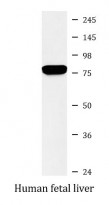ARG43179
anti-RANK antibody
anti-RANK antibody for Western blot and Human
Overview
| Product Description | Rabbit Polyclonal antibody recognizes RANK |
|---|---|
| Tested Reactivity | Hu |
| Tested Application | WB |
| Host | Rabbit |
| Clonality | Polyclonal |
| Isotype | IgG |
| Target Name | RANK |
| Antigen Species | Human |
| Immunogen | Synthetic peptide derived from Human RANK. |
| Conjugation | Un-conjugated |
| Alternate Names | ODFR; Osteoclast differentiation factor receptor; OFE; FEO; CD265; PDB2; CD antigen CD265; RANK; Receptor activator of NF-KB; OPTB7; Tumor necrosis factor receptor superfamily member 11A; TRANCER; LOH18CR1; OSTS |
Application Instructions
| Application Suggestion |
|
||||
|---|---|---|---|---|---|
| Application Note | * The dilutions indicate recommended starting dilutions and the optimal dilutions or concentrations should be determined by the scientist. | ||||
| Positive Control | Human fetal liver | ||||
| Observed Size | ~ 77 kDa |
Properties
| Form | Liquid |
|---|---|
| Purification | Affinity purified. |
| Buffer | PBS (pH 7.4), 150 mM NaCl, 0.02% Sodium azide and 50% Glycerol. |
| Preservative | 0.02% Sodium azide |
| Stabilizer | 50% Glycerol |
| Storage Instruction | For continuous use, store undiluted antibody at 2-8°C for up to a week. For long-term storage, aliquot and store at -20°C. Storage in frost free freezers is not recommended. Avoid repeated freeze/thaw cycles. Suggest spin the vial prior to opening. The antibody solution should be gently mixed before use. |
| Note | For laboratory research only, not for drug, diagnostic or other use. |
Bioinformation
| Database Links |
Swiss-port # Q9Y6Q6 Human Tumor necrosis factor receptor superfamily member 11A |
|---|---|
| Gene Symbol | TNFRSF11A |
| Gene Full Name | tumor necrosis factor receptor superfamily, member 11a, NFKB activator |
| Background | The protein encoded by this gene is a member of the TNF-receptor superfamily. This receptors can interact with various TRAF family proteins, through which this receptor induces the activation of NF-kappa B and MAPK8/JNK. This receptor and its ligand are important regulators of the interaction between T cells and dendritic cells. This receptor is also an essential mediator for osteoclast and lymph node development. Mutations at this locus have been associated with familial expansile osteolysis, autosomal recessive osteopetrosis, and Paget disease of bone. Alternatively spliced transcript variants have been described for this locus. [provided by RefSeq, Aug 2012] |
| Function | Receptor for TNFSF11/RANKL/TRANCE/OPGL; essential for RANKL-mediated osteoclastogenesis. Involved in the regulation of interactions between T-cells and dendritic cells. [UniProt] |
| Cellular Localization | Isoform 1: Cell membrane; Single-pass type I membrane protein. Isoform RANK-e5a: Cell membrane; Single-pass type I membrane protein. [UniProt] |
| Calculated MW | 66 kDa |
Images (1) Click the Picture to Zoom In






